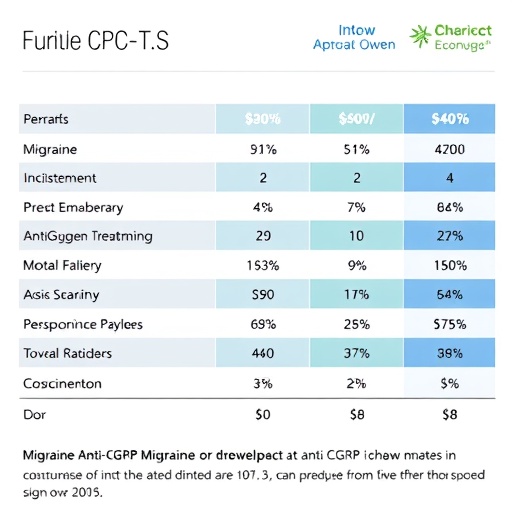Recent advances in migraine management have opened new avenues for patients who have struggled with multiple preventive treatments that have yielded inadequate relief. A groundbreaking study led by Mitsikostas et al. sheds light on the efficacy of anti-CGRP monoclonal antibodies, a novel class of medications designed to prevent migraine attacks. This comprehensive research, published in Adv Ther, examines the number needed to treat (NNT) and the cost per responder, providing vital insights into the economic implications of these medications for adult patients with difficult-to-treat migraines.
Migraines are debilitating neurological disorders that affect millions of individuals globally. Traditional treatments, including various oral preventive medications, can often be insufficient or cause intolerable side effects. Consequently, patients frequently experience a cycle of trial and error in search of effective relief. Recognizing this urgent need for improved options, scientists have focused on targeting the calcitonin gene-related peptide (CGRP), a crucial player in the migraine pathophysiology. The emergence of anti-CGRP monoclonal antibodies represents a substantial shift in migraine preventive therapy, aiming to disrupt this cycle.
The research team’s article meticulously outlines the NNT for patients who have not responded to previous migraine treatments. NNT quantifies the number of patients who need to be treated with a particular therapy for one patient to show a significant beneficial effect. This metric is particularly vital in clinical settings where healthcare providers strive to make informed decisions based on efficiency and effectiveness, especially when introducing novel therapies into practice. Patients suffering from chronic migraines need solutions that do not just promise effectiveness but also deliver tangible results that can significantly enhance their quality of life.
Moreover, the economic impact of these medications cannot be overlooked. The cost per responder analysis provides an essential framework that assesses the financial feasibility of integrating anti-CGRP monoclonal antibodies into standard migraine care regimens. Given the high costs associated with these biologics, including especially the frequent injection regimens, understanding the cost versus benefit becomes crucial for both healthcare systems and patients. The study presents an in-depth analysis of how much healthcare providers might expect to pay for each responder while providing valuable insights that could guide policy decisions on treatment funding and insurance coverage.
As the research illustrates, the potential for these drugs to transform migraine management exists. Individuals who previously faced frustration due to the ineffectiveness of traditional therapies may find relief through these innovative solutions. Yet, it is vital to assess these antidotes’ real-world applicability. In scenarios where a substantial number of patients remain unresponsive to other treatment modalities, the introduction of anti-CGRP monoclonal antibodies has the potential to offer a lifeline, significantly reducing the burden of disease.
The study’s design reflects a rigorous evaluation of available clinical data. By aggregating information from various clinical trials, Mitsikostas and colleagues are not just reporting findings; they are contributing to the broader body of evidence that informs clinical practice. Detailed statistical analyses reveal a promising efficacy profile that strengthens the argument for the inclusion of these agents in treatment algorithms. Furthermore, this comprehensive approach allows healthcare providers to understand better which patients are most likely to benefit, potentially streamlining treatment pathways.
As healthcare continues evolving, patient-centered approaches become undeniably crucial. The findings highlighted in this article emphasize the necessity of developing strategies that prioritize the unique needs of individuals with chronic migraine. The identification of responders is fundamental. By delineating criteria for expected outcomes, practitioners can tailor treatment more effectively, aligning the choice of medication with patient characteristics and history.
In addition to clinical outcomes, the study underscores the broader implications such therapies have on patient well-being and their day-to-day functioning. The chronic nature of migraines can disrupt professional and personal life, often leading to significant emotional distress. Understanding how anti-CGRP monoclonal antibodies can provide relief not only addresses the physiological aspects of the condition but also contributes to the overall improvement of patients’ mental health and life satisfaction.
Further, the excitement surrounding the utilization of anti-CGRP monoclonal antibodies also invites scrutiny regarding safety and long-term effects. The article discusses concerns that healthcare providers must consider when prescribing these medications. Comprehensive assessments of potential side effects and adverse events are crucial as more patients begin treatment. As with any novel therapeutic agent, ongoing research and vigilance in monitoring long-term use consistently remain essential.
The study by Mitsikostas et al. marks a significant step forward in understanding how cost-effective these new agents could be for healthcare systems. By demonstrating the potential for substantial cost savings related to migraine burden, including reduced emergency room visits and less reliance on other expensive treatment modalities, the findings pave the way for policy discussions that could enhance access to these medications.
In conclusion, as researchers continue to investigate the best strategies for managing migraines, studies like this offer critical insights that guide not only clinical decision-making but also future research. The findings presented in the study point towards a promising horizon for migraine sufferers who have exhausted traditional therapeutic options. By combining clinical efficacy with economic viability, anti-CGRP monoclonal antibodies may represent the shift in paradigms that patients have long awaited.
Looking ahead, it will be imperative for the scientific community to delve deeper into understanding specific patient populations that stand to benefit the most from these therapies. Furthermore, ongoing collaboration between researchers and healthcare providers enhances the potential for optimizing treatment approaches, ultimately leading to an era of more personalized and effective migraine management solutions.
As healthcare systems confront evolving challenges concerning migraine treatment, the insights gleaned from Mitsikostas et al.’s research will undoubtedly influence future therapeutic choices. The investment in anti-CGRP monoclonal antibodies could represent a substantial return, not only in clinical outcomes but also in enhancing the quality of life for countless individuals who endure the agony of recurrent migraines.
Subject of Research: Anti-CGRP monoclonal antibodies for migraine prevention in adults
Article Title: Number Needed to Treat and Cost Per Responder Analysis of Anti-CGRP Monoclonal Antibodies for Migraine Prevention in Adults for Whom Prior Preventive Treatments have Failed
Article References:
Mitsikostas, D.D., Awad, S.F., Kongerslev, R. et al. Number Needed to Treat and Cost Per Responder Analysis of Anti-CGRP Monoclonal Antibodies for Migraine Prevention in Adults for Whom Prior Preventive Treatments have Failed.
Adv Ther (2025). https://doi.org/10.1007/s12325-025-03348-8
Image Credits: AI Generated
DOI: 10.1007/s12325-025-03348-8
Keywords: anti-CGRP monoclonal antibodies, migraine prevention, cost per responder, number needed to treat, chronic migraines, efficacy analysis
Tags: anti-CGRP monoclonal antibodiescalcitonin gene-related peptide targetingchallenges in migraine reliefcost-effectiveness of anti-CGRP treatmentseconomic implications of migraine therapiesefficacy of migraine treatmentsenduring migraine patient strugglesinnovative migraine therapiesmigraine management advancementsneurological disorder managementnumber needed to treat in migrainespreventive migraine medication options





